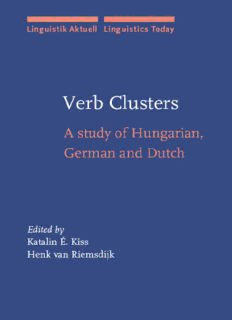
Verb Clusters: A Study of Hungarian, German and Dutch (Linguistik Aktuell Linguistics Today) PDF
Preview Verb Clusters: A Study of Hungarian, German and Dutch (Linguistik Aktuell Linguistics Today)
<DOCINFOAUTHOR""TITLE"VerbClusters:AstudyofHungarian,GermanandDutch"SUBJECT"LinguistikAktuell/LinguisticsToday,Volume69"KEYWORDS""SIZEHEIGHT"220"WIDTH"150"VOFFSET"4"> VerbClusters LinguistikAktuell/LinguisticsToday LinguistikAktuell/LinguisticsToday(LA)providesaplatformfororiginalmonographstudies intosynchronicanddiachroniclinguistics.StudiesinLAconfrontempiricalandtheoretical problemsasthesearecurrentlydiscussedinsyntax,semantics,morphology,phonology,and systematicpragmaticswiththeaimtoestablishrobustempiricalgeneralizationswithina universalisticperspective. SeriesEditors WernerAbraham EllyvanGelderen UniversityofVienna ArizonaStateUniversity AdvisoryEditorialBoard GuglielmoCinque IanRoberts UniversityofVenice CambridgeUniversity GüntherGrewendorf KenSafir J.W.Goethe-University,Frankfurt RutgersUniversity,NewBrunswickNJ LilianeHaegeman LisadeMenaTravis UniversityofLille,France McGillUniversity HubertHaider StenVikner UniversityofSalzburg UniversityofAarhus ChristerPlatzack C.Jan-WouterZwart UniversityofLund UniversityofGroningen Volume69 VerbClusters:AstudyofHungarian,GermanandDutch EditedbyKatalinÉ.KissandHenkvanRiemsdijk Verb Clusters A study of Hungarian, German and Dutch Editedby Katalin É. Kiss HungarianAcademyofSciences Henk van Riemsdijk TilburgUniversity JohnBenjaminsPublishingCompany Amsterdam(cid:1)/(cid:1)Philadelphia TM Thepaperusedinthispublicationmeetstheminimumrequirements 8 ofAmericanNationalStandardforInformationSciences–Permanence ofPaperforPrintedLibraryMaterials,ansiz39.48-1984. LibraryofCongressCataloging-in-PublicationData VerbClusters:AstudyofHungarian,GermanandDutch/editedbyKatalinÉ. KissandHenkvanRiemsdijk. p. cm.(LinguistikAktuell/LinguisticsToday,issn0166–0829;v.69) Includesbibliographicalreferencesandindexes. 1.Hungarianlanguage--Verbphrase.2.Germanlanguage--Verb phrase.3.Dutchlanguage--Verbphrase.I.Kiss,KatalinÉ.II.Riemsdijk,Henk C.van.III.Linguistikaktuell;Bd.69. PH2271.V47 2004 415’.6-dc22 2004045066 isbn9027227934(Eur.)/1588115070(US)(Hb;alk.paper) ©2004–JohnBenjaminsB.V. Nopartofthisbookmaybereproducedinanyform,byprint,photoprint,microfilm,or anyothermeans,withoutwrittenpermissionfromthepublisher. JohnBenjaminsPublishingCo.·P.O.Box36224·1020meAmsterdam·TheNetherlands JohnBenjaminsNorthAmerica·P.O.Box27519·Philadelphiapa19118-0519·usa Table of contents Introduction Verbclusters:Somebasicnotions 1 KatalinÉ.KissandHenkvanRiemsdijk I. Dataandtheories Data WestGermanicverbclusters:Theempiricaldomain 43 SusiWurmbrand Hungarianverbalclusters:Resultsofaquestionnairesurvey 87 KrisztaSzendro˝iandIldikóTóth Theories Clusteringtheories 121 JonathanDavidBobaljik “Roll-up”structuresandmorphologicalwords 147 MichaelBrody Thestructureofclusters 173 EdwinWilliams II. Forcesandfactors Prosody Astress-basedapproachtoclimbing 205 KrisztaSzendro˝i Particlesandphonologicallydefectivepredicates 225 AnikóCsirmaz Tableofcontents Aspect Climbingforaspect:Withnorucksack 253 GáborAlberti TheHungarianverbalcomplex:Analternativeapproach 291 CsabaOlsvay VO/OV ParallelstrategiesofverbalcomplexformationinHungarian andWest-Germanic? 335 KatalinÉ.Kiss Dopreverbsclimb? 359 PeterAckema Morphology Verbalcomplexesandmorphosyntacticmerger 395 HubaBartos InfinitivalcomplementsofmodalsinHungarianandinGerman 417 IldikóTóth Agreementand‘clauseunion’ 445 MarceldenDikken Namesindex 499 Subjectindex 503 Listofcontributors 511 Verb clusters Some basic notions KatalinÉ.KissandHenkvanRiemsdijk . Openingremarks Manylanguageshaveconstructionsinwhichverbscluster.Thismayoftensimply be the result of center-embedded complementation in SOV-languages, but lan- guages find many other ways to cluster verbs: they make use of auxiliaries, they moveverbsintoeachother’sproximity,theyincorporateverbs,ortheyuseserial verbconstructions.Often,theresultingverbclusterhasspecialproperties,suchas unexpectedorderingoftheverbsinthecluster.Andfrequently,theresultingcom- plexsentenceissomewherebetweenmulti-clausalandmono-clausal.Verbclusters, therefore, constitute an interesting sub-field of linguistic enquiry that addresses questionsthatrangefrommorphologicalissuesviasyntaxtosemanticproblems. Exceptionally large verb clusters (up to five or even more verbs) are found both in Hungarian and in the West-Germanic OV-languages. And furthermore, theyshowanumberofremarkableandunexpectedsimilaritiesintheirstructure, inparticularinnon-canonicalorderingsoftheverbs.Fromtheperspectiveofthe geneticoriginoftheselanguages(Indo-Europeanvs.Non-Indo-European)thisis quitesurprising.Butfromtheperspectiveoflanguagecontact,thesimilarityisper- hapslesssurprising;afterall,theselanguages(morespecificallytheSouth-Eastern representativesofthecontiguousWest-GermanicOV-languagegroup)haveexisted inclosecontactforaconsiderableamountoftime.Inotherwords,itcouldbethe casethat we are seeing anareal syntactic feature.What we presentinthepresent book is essentially an exploration of the properties of these constructions in the twogeographicaldomainsandasurveyofthetheoreticalapproachesthatcanbe adoptedinaccountingforverbclusterphenomenaofthiskind. Thepresentbookbynomeanspurportstocoverthemanyanglesthatshould becoveredinafull-scaleinvestigationofalanguagecontactsituation.Wesimply havetoolittleinformationaboutandinsightinthehistoricaldevelopmentofthese KatalinÉ.KissandHenkvanRiemsdijk particularphenomenainthelanguagesinquestionandtheincidenceandpatterns ofmultilingualisminthecontactareaasfarasverbclustersareconcerned.What thisbookdoesofferisadetailedsyntactic studyoftherelevantverbclusterphe- nomena.Itprovidesanextensiveempiricalsurveyofthepatternsfound,including ampledialectinformation.Italsodiscussesavarietyoftheoriesthathavebeende- vised toaccount for the existence and structure of verb clusters.And it contains articlesthatexaminespecific factorsoraspectsthatplayaparticularlyimportant role in the syntactic analysis of verb clusters: prosody, aspect, basic word order and morphology. In this sense, the book provides the syntactic underpinnings foramoreextensive,multidisciplinaryinvestigationofthiswidelyoverlookedbut extremelyrichandpotentiallyfertileareaofsyntacticinvestigation. . Somepropertiesofverbclusters:TheviewfromGermanic . Isthereacluster? In Dutch, there are two main strategies for complementation: extraposition and verbraising.Thelattertermistheoneusedmostlyinthegenerativesyntaxtradi- tion,butitissomewhattheoryladen,soithasbeenreplacedby‘verbcluster’(VC) here,which should be takenin asomewhat neutral interpretation because it too ispotentiallymisleading:eitheritreferstoastringofmoreorlessadjacentverbs, or it refers to a string of verbs that form a constituent together at some level of analysis.Similarly,byextraposition(EX)wemeanclausalunitsintheclause-final position,thatis,totherightofthematrixverbcluster.Inotherwords,bytheuse of this term we do not mean to takea side in the questionof how extraposition structuresaretobederived.TheissueoftheconstituencyoftheVCisatthecore ofthepresentsection. ThetwovariantsareexemplifiedbelowforGermanandDutch: (1) a. ...dass er verspricht [eine Geschichte zu erzählen] (EX) that he promises a story to tell (cid:1) a. ...dathijbelooft [eenverhaaltevertellen] b. ...dasser[eineGeschichtezuerzählen]verspricht (VC) b(cid:1). ...dathij[eenverhaalbeloofttevertellen] In(1a),thecomplementclause,hereinfinitival withacontrolledsubject,isinte- grallyplacedattheendoftheclause.Weneednotbeconcernedwithextraposition clausesexcepttotheextentthattheyareusedasastandardofcomparisonagainst whichVC-examplesarechecked.Ascaneasilybeseenin(1b),thetwoverbshere areadjacent,andthequestionindeedariseswhethersuchsequencesofverbs,which Verbclusters cansometimesattainalengthofuptosixormoreverbs,haveanyspecialproperties orstatusinsyntax,morphology,orsemantics. ItwasEvers(1975)whofirstarguedthatindeedVCswereconstituentswhich, inhisproposal,arisefromadjoiningtheembeddedverbtothematrixverb.This ideawasinspiredquitedirectlybythefactthatintheDutchexample(1b’)theorder oftheverbsisinverted,raisingimmediatequestionsastotheconstituentstructure. Thestructurewouldthenbesomethinglike(2): (2) a. ...dasser[eineGeschichte[]][zuerzählen verspricht] i i b. ...dathij[eenverhaal[]][beloofttevertellen] i i PartofEvers’evidenceforthisconstituentstructurecamefromgapping,butmuch of it is unclear and furthermore too little is known about the properties of gap- ping to base any firm conclusions on such considerations. See Evers (1975) for discussion. . Adjacency Asecondlineofargumentationwhichisrelevant,thoughnot,perhaps,conclusive, istheadjacencywhichisfoundamongtheverbs,atleastinDutch.Thesituationin Germanismorecomplex,amattertowhichwereturnbrieflyinSection2.5below. Thefollowing discussionisbased(almostverbatim)onthepresentationofthese factsinvanRiemsdijk(1998). Thereare twologicallypossiblesourcesforinterveningelements,extraposed elementsintheembeddedclause,orelementsinterveningbetweenthematrixverb andthecomplementclause.Thisisschematicallyshownin(3). (3) *...[ ...[ ...[e] W ]W [V V]]unlessW ,W =Ø MATRIX COMPLEMENT i 1 2 j i 1 2 ConsiderfirstthecaseofW .SupposewehaveanembeddedclausewithaPPthat 1 canbeextraposedundernormalcircumstances,whichobtain,forexample,when the(bracketed)complementclauseisitselfextraposed.Thisisillustratedin(4). (4) a. dat hij probeert [de emmer met een lepel leeg te that he tries the bucket with a spoon empty to scheppen] scoop ‘thathetriestoscoopthebucketemptywithaspoon’ b. *dathijprobeert[deemmerleegmeteenlepeltescheppen] c. dathijprobeert[deemmerleegtescheppenmeteenlepel]
